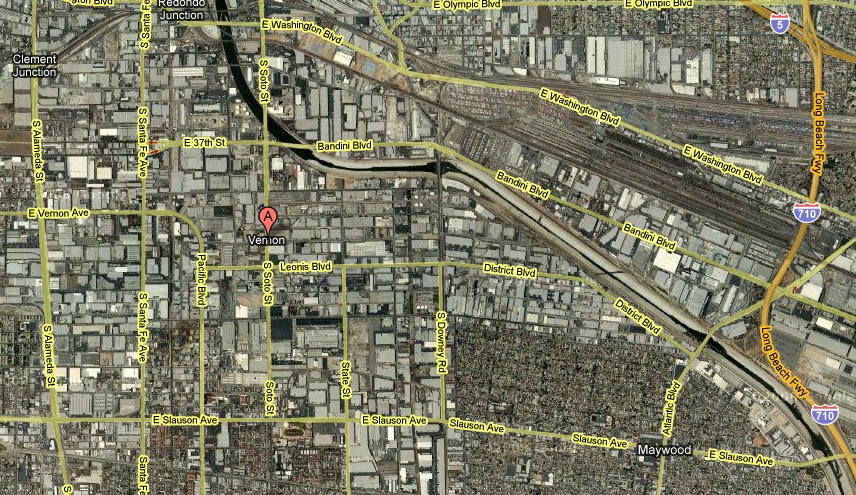 The city of Vernon, CA, purchased two industrial buildings totaling 62,555 square feet in Vernon from Central City Box & Paper for a total of $4 million, or about $64 per square foot. The deal included the vacant facilities at 2716 and 2724 Leonis Blvd. The city plans to hold the properties, which are adjacent to a city-owned power plant, for future development.
The city of Vernon, CA, purchased two industrial buildings totaling 62,555 square feet in Vernon from Central City Box & Paper for a total of $4 million, or about $64 per square foot. The deal included the vacant facilities at 2716 and 2724 Leonis Blvd. The city plans to hold the properties, which are adjacent to a city-owned power plant, for future development.
Tag Archives: city of vernon
Vernon Livestock Rendering Plant

Baker seizes on fat wherever it can: dairy cows that have died in the heat of the Central Valley, the trimmings left over from the purchase of a Niman Ranch roast at Whole Foods, steaks and chickens whose shelf life at Pavilions has expired. The company retrieves grease from deep fryers at McDonald’s and the drippings of ribs in the Vons hot section. Rendering is the most elemental form of recycling, the regeneration of the dead into soap and scented creams. It has existed for millennia in societies, and its reach in modern America is staggering. We live in a vast cycle of fat reclamation, one that stretches from the killing floors of the Midwest to our medicine cabinets, making a stop along the way at the local Burger King.
Every restaurant and fast-food stand in L.A. has a fat reservoir called a grease trap, usually secreted under the parking lot. A trap may strain as much as 15,000 gallons of liquid fat from a kitchen’s drains, though the speed at which it fills depends on what’s cooking upstairs. A Burger King trap can take three months to fill, while an El Pollo Loco trap might need to be emptied in weeks. There are tens of thousands of grease traps citywide, each a promising revenue source for rendering companies. Baker taps around 8,000 of them.
Biodiesel! About 40 pounds of good ground beef heated to 250 degrees will produce enough tallow to make a gallon of biodiesel. The process is insanely wasteful if cattle are raised for it alone; you’d need to boil an entire cow to fill your Chevy Volt. Yet there’s no shortage of cow remnants in slaughterhouses, and U.S. production of biodiesel from renderers has grown from 78,000 metric tons in 2007 to 400,000 metric tons in 2008.
The City of Vernon And Its Industries
The City of Vernon is the smallest among the cities of Los Angeles County when ranked by geographic area or population. The city’s economic impact, however, is far larger than one might expect. Indeed, as one of Los Angeles County’s “industrial cities” – along with the Cities of Commerce and Industry – Vernon is a vital economic center.
Given its industrial profile, Vernon plays its biggest role in the Food Manufacturing area. Vernon-based food product companies employ almost 10,700 workers, more than 15% of the Los Angeles County total for this group. Vernon also plays an important role in the region’s Fashion–Apparel and Textile Design/Manufacturing/ Wholesale industry cluster, with more than 11,200 employees or 10.66% of the L.A. County total.
Other regional industry clusters in which Vernon plays a large role include Furniture and Home Furnishings (with an employment share of 5.53%), Fabricated Metal Products and Industrial Machinery (with 3.4%), Toys (with 2.4%), Auto Parts (also 2.4%), and Wholesale Trade and Logistics (with nearly 2%).
Vernon, due to its historic role as a meat packing center, has long been home to a variety of animal waste processing and rendering industries. Rendering, for those who don’t know, is a process that converts waste animal tissue into stable, value-added materials such as lard, tallow or bone meal. Rendering can refer to any processing of animal byproducts into more useful materials, or more narrowly to the rendering of whole animal fatty tissue into purified fats.
Sources: City of Vernon, California Employment Development Department (QCEW data series), LAEDC.
Real Mex Food Expands Food Processing Plant

In February, Real Mex closed its 32,000-square-foot manufacturing plant in Santa Fe Springs, Calif., and moved into a 100,000-square-foot space in Vernon, California. The city of Vernon and a developer came to us and proposed a deal where we got a 100,000-square-foot building retrofitted to a state-of-the-art USDA manufacturing plant, Angulo explains. It was an opportunistic deal. They got us into 100,000 square feet at the cost that we would have gotten a build-to-suit 65,000-square-foot building.
Food safety also was a major priority for Real Mex in building out the new plant. The company built an in-house lab and hired a complete quality assurance team. Other food safety precautions include a triple boiler system, floor foamers, centralized sanitation system, in-house chlorination system for vegetables and a full quality assurance staff.
The developer invested $10 million in the build out, while Real Mex spent about $4 million on equipment. The completely refurbished plant quadrupled the company’s previous capacity and allowed it to more than double the number of kettles, tumble chillers and blast freezers. www.realmexfoods.com


